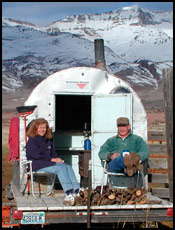
Ron Torell with his wife, Jackie.
Cow Camp Chatter
Biological cycle of the beef cow
One of the most fundamental principles of beef cow management is understanding the biological cycle of the beef cow. This basic principle reveals how a cow's nutrient demands change at each stage of her production. With this specific knowledge under your hat, you as a manager will be better equipped to manage reproduction.
The biological cycle of the beef cow is constant and well-defined. It can be divided into four periods. The first, second and third trimesters of gestation are each 94 days in duration. Given this, the duration of a cow's pregnancy is approximately 282 days. In order for a cow to rebreed and calve at the same time the following year, the postpartum period should be no longer than 83 days.
The postpartum interval is that portion of the biological cycle that has the highest nutrient demand for a cow. This is the period from calving to first estrus. In addition to the trauma of calving, the cow is lactating. This is a huge draw nutritionally, especially if she is genetically a heavy milker. Her uterus is involuting and preparing for estrus. A spring-calving cow is just seeing green grass and may be thin from overwintering.
Nutrient demand, by trimester
The first trimester begins the day the cow conceives. Ideally, this should be 80 to 90 days after calving. The first trimester of pregnancy has the third-highest nutrient demand in the cow's biological cycle. Peak lactation has come and gone, but there is still a significant draw for the production of milk. Along with this, the cow has the continuous suckling effect, which suppresses estrus. By and large, spring-calving cows may still have green grass to help meet or exceed their nutrient demands.
The second trimester of pregnancy begins at 94 days after conception and carries the least nutrient demand for the beef cow. This is especially true if the calf is weaned early in the second trimester.
Peak lactation has come and gone. Weaning generally occurs during this period. The decision of when to wean should depend on the nutrient supply and body condition of the cow.
Usually, when the grass starts drying up and losing its punch, the cow will start losing body condition. Lactation on dry feed can rapidly make a thin cow out of a fleshed cow. On the other hand, given time, a dry cow in the second trimester of pregnancy can actually add condition on dry feed, provided there is no calf tugging on her. Add a supplement to the equation and you are building body condition that may benefit the cow for overwintering and breed-back in the following year.
The last trimester of pregnancy begins 188 days after conception. Next to the postpartum period, the last trimester of pregnancy is the period of highest nutrient demand of a cow's biological cycle. Two-thirds of a calf's fetal development occurs in the last trimester of pregnancy.
Adequate body condition should be banked on the cow by now. This allows a savings account of energy for her to draw from in time of need. It is not economical to flesh a cow at this stage of production. This puts the thin cow and her fetus at a strong disadvantage going into the postpartum interval.
Nutrient partitioning
With a renewed understanding of the biological cycle of a beef cow, it's important to have a simplified clarification of nutrient partitioning. This translates into knowing what nutrient demands are met first by the cow.
- 1. Maintenance. This entails all the energy necessary for breathing, digestion, walking, maintaining body temperature and other body functions.
- 2. Growth. Once maintenance needs are met, energy goes to growth. A young female is still growing after her first and even second calf, so she will require more energy compared to a female that has reached mature size.
- 3. Milk Production. After growth, nutrients and energy are then used for milk production. If all the female's energy goes into maintenance and growth, then she will not produce enough milk for her calf.
- 4. Reproduction. Only after the requirements of all other functions have been met will a female's reproductive system develop and function.
That's enough for this month. A special thanks to my wife, Jackie, for her part in writing "Cow Camp Chatter." As always, if you would like to discuss this article or simply want to talk cows, do not hesitate to contact me at 775-385-7665 or e-mail me.











